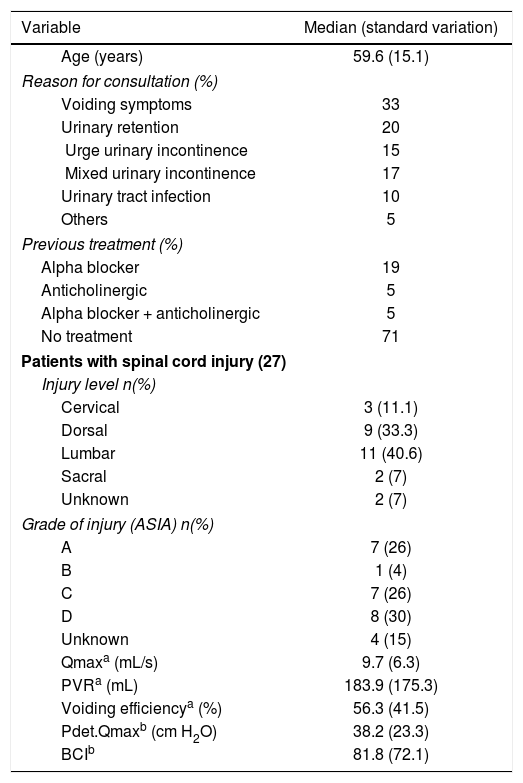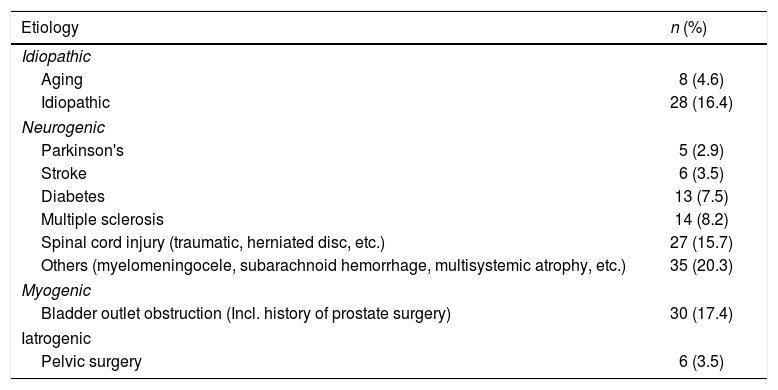The objective of the study was to compare the evolution of male patients with neurogenic detrusor underactivity (NDU) versus non-neurogenic DU (NNDU) and to establish risk factors to predict the need for clean intermittent catheterization (CIC) during the follow-up period.
Material and methodsLongitudinal, descriptive study of a cohort of patients diagnosed with DU, and 2496 urodynamic studies (2008–2018) were reviewed. Patients with DU (ICS 2002 and/or Bladder contraction index (<100)) without treatment were included. Patients with CIC or interventional treatment were excluded. Follow-up included flowmetry every six months. CIC was indicated in cases of high residual volume (PVR) >200mL or voiding efficiency (VE) <50%. The need for CIC during follow-up or the appearance of complications (urinary tract infections (UTI), bladder lithiasis) were compared.
ResultsDU was found in 172 (6.89%) men. Neurological causes were observed in 106 (61,6%) cases. Finally, 62 patients were included with a mean follow-up of 4.9 years (±2.6). Of these patients, 33 (53%) presented NDU and 29 (47%) NNDU. Six patients with NDU needed CIC versus none with NNDU (p=0.04). Patients requiring CIC had higher PVR (p=0.009) and lower VE (p=0.017)), and there were also differences in terms of time until the need for CIC (log Rank: 0.009), which was 15.1 months [4–38]. In the multivariate analysis, none of the variables showed to be predictive of the need for CIC.
ConclusionsThe most common cause of DU is neurologic injury. Patients with NDU remain stable without requiring CIC. We have not detected any risk factors that identify patients at risk of needing CIC.
El objetivo del trabajo fue comparar la evolución de pacientes varones con detrusor hipoactivo (DU) neurógeno (DUN) frente a DU no neurógeno (DUNoN) y establecer factores de riesgo para predecir la necesidad de cateterismo limpio intermitente (CLI) en el seguimiento.
Material y métodosEstudio longitudinal, descriptivo, sobre una cohorte de pacientes con diagnóstico de DU. Se revisaron 2.496 estudios urodinámicos (2008-2018). Se incluyeron pacientes con DU (ICS2002 y/o Bladder contraction index [< 100]) sin tratamiento. Se excluyeron pacientes en CLI o tratamiento intervencionista. Se realizó seguimiento semestralmente con flujometría. Se indicó CLI ante residuos elevados (RPM) > 200mL o eficiencia de vaciado (EV) < 50%. Se comparó la necesidad de CLI durante el seguimiento o la aparición de complicaciones (infecciones urinarias [ITU], litiasis vesical).
ResultadosSe encontraron 172 (6,89%) varones con DU. En 106 (61,6%) se evidenció causa neurológica. Finalmente se incluyeron 62 pacientes con seguimiento medio de 4,9 años (+/-2,6). De ellos, 33 (53%) fueron DUN y 29 (47%) DUNoN. No se apreciaron diferencias en la aparición de ITU (p=0,34) o litiasis vesicales (p=0,39). Seis pacientes con DUN precisaron CLI frente a ninguno con DUNoN (p=0,04). Los pacientes que requirieron CLI presentaron mayor RPM [p=0,009]) y menor EV [p=0,017]). También se apreciaron diferencias en el tiempo hasta la necesidad de CLI (log rank: 0,009), siendo este de 15,1 meses (4-38). En el análisis multivariante ninguna de las variables pudo demostrarse como factor predictivo de necesidad de CLI.
ConclusionesLa causa más frecuente de DU es la lesión neurológica. Los pacientes con DUN permanecen estables sin necesidad de CLI. No hemos detectado factores de riesgo que identifiquen a los pacientes en riesgo de necesitar CLI.
Artículo
Comprando el artículo el PDF del mismo podrá ser descargado
Precio 19,34 €
Comprar ahora












